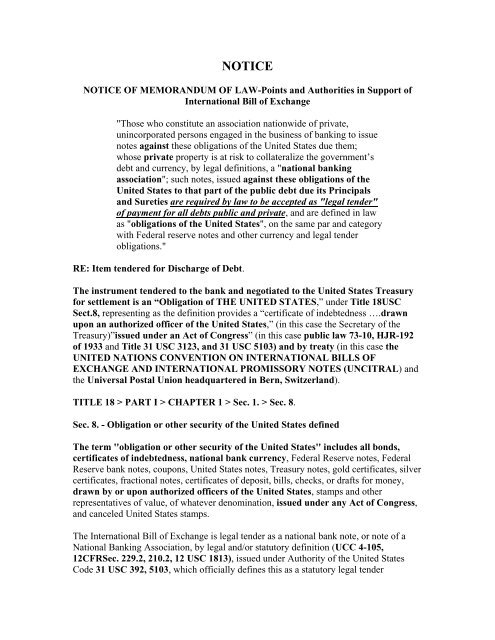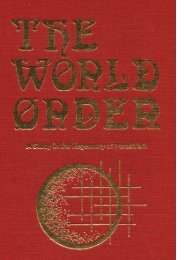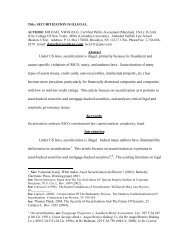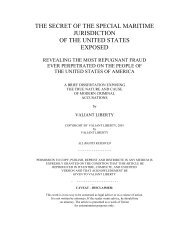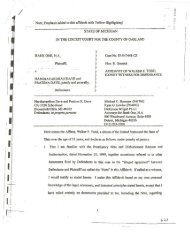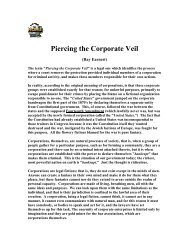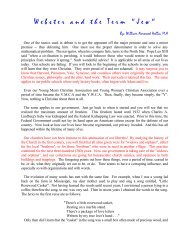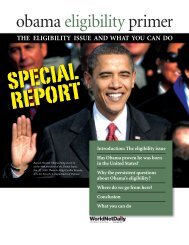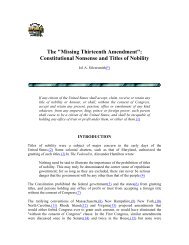NOTICE OF MEMORANDUM OF LAW-Points and ... - My Private Audio
NOTICE OF MEMORANDUM OF LAW-Points and ... - My Private Audio
NOTICE OF MEMORANDUM OF LAW-Points and ... - My Private Audio
Create successful ePaper yourself
Turn your PDF publications into a flip-book with our unique Google optimized e-Paper software.
<strong>NOTICE</strong><br />
<strong>NOTICE</strong> <strong>OF</strong> <strong>MEMORANDUM</strong> <strong>OF</strong> <strong>LAW</strong>-<strong>Points</strong> <strong>and</strong> Authorities in Support of<br />
International Bill of Exchange<br />
"Those who constitute an association nationwide of private,<br />
unincorporated persons engaged in the business of banking to issue<br />
notes against these obligations of the United States due them;<br />
whose private property is at risk to collateralize the government’s<br />
debt <strong>and</strong> currency, by legal definitions, a "national banking<br />
association"; such notes, issued against these obligations of the<br />
United States to that part of the public debt due its Principals<br />
<strong>and</strong> Sureties are required by law to be accepted as "legal tender"<br />
of payment for all debts public <strong>and</strong> private, <strong>and</strong> are defined in law<br />
as "obligations of the United States", on the same par <strong>and</strong> category<br />
with Federal reserve notes <strong>and</strong> other currency <strong>and</strong> legal tender<br />
obligations."<br />
RE: Item tendered for Discharge of Debt.<br />
The instrument tendered to the bank <strong>and</strong> negotiated to the United States Treasury<br />
for settlement is an “Obligation of THE UNITED STATES,” under Title 18USC<br />
Sect.8, representing as the definition provides a “certificate of indebtedness ….drawn<br />
upon an authorized officer of the United States,” (in this case the Secretary of the<br />
Treasury)”issued under an Act of Congress” (in this case public law 73-10, HJR-192<br />
of 1933 <strong>and</strong> Title 31 USC 3123, <strong>and</strong> 31 USC 5103) <strong>and</strong> by treaty (in this case the<br />
UNITED NATIONS CONVENTION ON INTERNATIONAL BILLS <strong>OF</strong><br />
EXCHANGE AND INTERNATIONAL PROMISSORY NOTES (UNCITRAL) <strong>and</strong><br />
the Universal Postal Union headquartered in Bern, Switzerl<strong>and</strong>).<br />
TITLE 18 > PART I > CHAPTER 1 > Sec. 1. > Sec. 8.<br />
Sec. 8. - Obligation or other security of the United States defined<br />
The term ''obligation or other security of the United States'' includes all bonds,<br />
certificates of indebtedness, national bank currency, Federal Reserve notes, Federal<br />
Reserve bank notes, coupons, United States notes, Treasury notes, gold certificates, silver<br />
certificates, fractional notes, certificates of deposit, bills, checks, or drafts for money,<br />
drawn by or upon authorized officers of the United States, stamps <strong>and</strong> other<br />
representatives of value, of whatever denomination, issued under any Act of Congress,<br />
<strong>and</strong> canceled United States stamps.<br />
The International Bill of Exchange is legal tender as a national bank note, or note of a<br />
National Banking Association, by legal <strong>and</strong>/or statutory definition (UCC 4-105,<br />
12CFRSec. 229.2, 210.2, 12 USC 1813), issued under Authority of the United States<br />
Code 31 USC 392, 5103, which officially defines this as a statutory legal tender
obligation of THE UNTIED STATES, <strong>and</strong> is issued in accordance with 31 USC 3123<br />
<strong>and</strong> HJR-192 (1933) which establish <strong>and</strong> provide for its issuance as “Public Policy” in<br />
remedy for discharge of equity interest recovery on that portion of the public debt to its<br />
Principals, <strong>and</strong> Sureties bearing the Obligation of THE UNITED STATES.<br />
This is a statutory remedy for equity interest recovery due the principles <strong>and</strong> sureties of<br />
the United States for discharge of lawful debts in commerce in conjunction with US<br />
obligations to that portion of the public debt it is intended to reduce.<br />
During the financial crisis of the depression, in 1933 substance of gold, silver <strong>and</strong> real<br />
money was removed as a foundation for our financial system.<br />
In it s place the substance of the American citizenry: their real property, wealth, assets<br />
<strong>and</strong> productivity that belongs to them was, in effect, ‘pledged’ by the government <strong>and</strong><br />
placed at risk as the collateral for US debt, credit <strong>and</strong> currency for commerce to<br />
function.<br />
This is well documented in the actions of Congress <strong>and</strong> the President at that time <strong>and</strong> in<br />
the Congressional debates that preceded the adoption of the reorganizational measures:<br />
Senate Document No. 43, 73rd Congress, 1st Session, stated,<br />
"Under the new law the money is issued to the banks in return for Government<br />
obligations, bills of exchange, drafts, notes, trade acceptances, <strong>and</strong> banker’s<br />
acceptances. The money will be worth 100 cents on the dollar, because it is backed<br />
by the credit of the nation. It will represent a mortgage on all the homes <strong>and</strong> other<br />
property of all the people in the Nation." (Which lawfully belongs to these private<br />
citizens.)<br />
The National Debt is defined as “mortgages on the wealth <strong>and</strong> income of the people of<br />
a country.” (Encyclopedia Britannica, 1959.)<br />
Their wealth, …. their income.<br />
The reorganization is evidenced by:<br />
The Emergency Banking Act, March 9, 1933,<br />
House Joint Resolution 192, June 5, 1933 (public law 73-10)<br />
And the Series of Executive Orders that surrounded them:<br />
6073- Reopening of Banks. Embargo on Gold Payments <strong>and</strong> Exports, <strong>and</strong> Limitations on<br />
Foreign Exchange Transactions. March 10, 1933<br />
6111-Transactions in foreign exchange are permitted under Governmental Supervision.<br />
April 20, 1933<br />
6102 - Forbidding the hoarding of gold coin, gold bullion <strong>and</strong> gold certificates. April 5,<br />
On December 23, 1913, Congress had passed "An Act to provide for the establishment of<br />
Federal reserve banks, to furnish an elastic currency, to afford a means of rediscounting<br />
commercial paper, to establish a more effective supervision of banking in the United
States, <strong>and</strong> for other purposes". The Act is commonly known as the "Federal Reserve<br />
Act".<br />
One fo the purposes for enacting the Federal Reserve Act was:<br />
(3) to authorize "hypothecation" of obligations including "United States bonds or<br />
other securities which Federal reserve Banks are authorized to hold" under Section<br />
14(a); 12 USC; ch. 6, 38 Stat. 251 Sect 14(a)<br />
The term "hypothecation" as stated in Section 14(a) of the Act is defined:<br />
"1. Banking. Offer of stocks, bonds, or other assets owned by a party other<br />
than the borrower as collateral for a loan, without transferring title. If the<br />
borrower turns the property over to the lender who holds it for safekeeping, the<br />
action is referred to as a pledge. If the borrower retains possession, but gives<br />
the lender the right to sell the property in event of default, it is a true<br />
hypothecation.<br />
2. Securities. The pledging of negotiable securities to collateralize a broker's margin<br />
loan. The broker pledges the same securities to a bank as collateral for a broker's loan, the<br />
process is referred to as rehypothecation."<br />
[Dictionary Of Banking Terms, Fitch, pg. 228 (1997)]<br />
As seen from the definitions, in hypothecation there is equitable risk to the actual owner.<br />
Section 16 of the current Federal Reserve Act, which is codified at 12 USC 411, declares<br />
that "Federal Reserve Notes" are "obligations of the United States".<br />
So we see the "full faith <strong>and</strong> credit" of the United States: which is the substance of the<br />
American citizenry: their real property, wealth, assets <strong>and</strong> productivity that belongs to<br />
them, is thereby hypothecated <strong>and</strong> rehypothecated by the United States to its<br />
obligations as well as to the Federal Reserve for the issuance <strong>and</strong> backing of Federal<br />
Reserve Notes as legal tender "for all taxes, customs, <strong>and</strong> other public dues".<br />
TITLE 12 > CHAPTER 3 > SUBCHAPTER XII > Sec. 411.<br />
Sec. 411. - Issuance to reserve banks; nature of obligation; redemption<br />
Federal Reserve notes, to be issued at the discretion of the Board of Governors of the<br />
Federal Reserve System for the purpose of making advances to Federal reserve banks<br />
through the Federal reserve agents as hereinafter set forth <strong>and</strong> for no other purpose, are<br />
authorized. The said notes shall be obligations of the United States <strong>and</strong> shall be<br />
receivable by all national <strong>and</strong> member banks <strong>and</strong> Federal reserve banks <strong>and</strong> for all<br />
taxes, customs, <strong>and</strong> other public dues.
The commerce <strong>and</strong> credit of the nation continues on today under financial reorganization<br />
(Bankruptcy) as it has since 1933, still backed by the assets <strong>and</strong> wealth of the American<br />
citizenry: at risk for the government’s obligations <strong>and</strong> currency.<br />
Under the 14th amendment <strong>and</strong> numerous Supreme Court precedents, as well as in<br />
equity, <strong>Private</strong> property can not be taken or pledged for public use without just<br />
compensation, or due process of law . The United States can not pledge or risk the<br />
property <strong>and</strong> wealth of its private citizens, for any government purpose without<br />
legally providing them remedy to recover what is due them on their risk.<br />
This principle is so well established in English common law <strong>and</strong> in the history of<br />
American jurisprudence. The 14th amendment provides: “no person shall be deprived<br />
of…property without due process of law”.<br />
And Courts have long ruled to have one’s property legally held as collateral or surety for<br />
a debt even when he still owns it <strong>and</strong> still has it is to deprive him of it since it is at risk<br />
<strong>and</strong> could be lost for the debt at any time.<br />
The United States Supreme Court said, in United States v. Russell [13 Wall, 623, 627]<br />
"<strong>Private</strong> property, the Constitution provides, shall not be taken for public use<br />
without just compensation.”<br />
"The right of subrogation is not founded on contract. It is a creature of equity; is<br />
enforced solely for the purpose of accomplishing the ends of substantial justice; <strong>and</strong> is<br />
independent of any contractual relations between the parties." Memphis & L. R. R.<br />
Co. v. Dow, 120 U.S. 287, 301-302 (1887).<br />
The rights of a surety to recovery on his risk or loss when st<strong>and</strong>ing for the debts of<br />
another was reaffirmed again as late as 1962 in Pearlman v. Reliance Ins.Co., 371 U.S.<br />
132 when the Court said:<br />
…”sureties compelled to pay debts for their principal have been deemed entitled to<br />
reimbursement, even without a contractual promise …And probably there are few<br />
doctrines better established…...”<br />
Black’s Law Dictionary , 5th edition, defines “surety”:<br />
“One who undertakes to pay or to do any other act in event that his principal fails<br />
therein. Everyone who incurs a liability in person or estate for the benefit of another,<br />
without sharing in the consideration, st<strong>and</strong>s in the position of a “surety.”<br />
Constitutionally <strong>and</strong> in the laws of equity, the United States could not borrow or pledge<br />
the property <strong>and</strong> wealth of its private citizens, put at risk as collateral for its<br />
currency <strong>and</strong> credit without legally providing them equitable remedy for recovery<br />
of what is due them.<br />
The United States government, of course, did not violate the law or the Constitution in<br />
this way, in order to collateralize its financial reorganization, but did, in fact, provide
such a legal remedy so that it has been able to continue on since 1933 to hypothecate the<br />
private wealth <strong>and</strong> assets of those classes of persons by whom it is owned, at risk<br />
backing the government’s obligations <strong>and</strong> currency, by their implied consent, through<br />
the government having provided such remedy, as defined <strong>and</strong> codified above, for<br />
recovery of what is due them on their assets <strong>and</strong> wealth at risk.<br />
The provisions for this are found in the same act of “Public Policy” HJR-192, public law<br />
73-10 that suspended the gold st<strong>and</strong>ard for our currency, abrogated the right to dem<strong>and</strong><br />
payment in gold, <strong>and</strong> made Federal Reserve notes for the first time legal tender, “backed<br />
by the substance or “credit of the nation”.<br />
All US currency since that time is only credit against the real property, wealth <strong>and</strong> assets<br />
belonging to the private soverign American people, taken <strong>and</strong>/or ‘pledged’ by THE<br />
UNITED STATES to its secondary creditors as security for its obligations.<br />
Consequently, those backing the nation’s credit <strong>and</strong> currency could not recover what was<br />
due them by anything drawn on Federal Reserve notes without exp<strong>and</strong>ing their risk<br />
<strong>and</strong> obligation to themselves. Any recovery payments backed by this currency would<br />
only increase the public debt its citizens were collateral for, which an equitable<br />
remedy was intended to reduce, <strong>and</strong> in equity would not satisfy anything.<br />
And there was no longer actual money of substance to pay anybody.<br />
There are other serious limitations on our present system. Since the institution of these<br />
events, for practical purposes of commercial exchange, there has been no actual<br />
money in circulation by which debt owed from one party to another can actually be<br />
repaid.<br />
Federal Reserve Notes, although made legal tender for all debts public <strong>and</strong> private in the<br />
reorganization, can only discharge a debt. Debt must be “paid” with value or substance<br />
(i.e. gold, silver, barter, labor, or a commodity). For this reason HJR-192<br />
(1933), which established the “public policy” of our current monetary system, repeatedly<br />
uses the technical term of “discharge” in conjunction with “payment” in laying out public<br />
policy for the new system. A debt currency system cannot pay debt.<br />
So from that time to the present, commerce in the corporate UNITED STATES <strong>and</strong><br />
among sub-corporate subject entities has had only debt note instruments by which debt<br />
can be discharged <strong>and</strong> transferred in different forms. The unpaid debt, created <strong>and</strong>/or<br />
exp<strong>and</strong>ed by the plan now carries a public liability for collection in that when debt is<br />
discharged with debt instruments, (i.e. Federal Reserve Notes included), by our<br />
commerce, debt is inadvertently being exp<strong>and</strong>ed instead of being cancelled, thus<br />
increasing the public debt. A situation potentially fatal to any economy.<br />
Congress <strong>and</strong> government officials who orchestrated the public laws <strong>and</strong> regulations that<br />
made the financial reorganization anticipated the long term effect of a debt based<br />
financial system which many in government feared, <strong>and</strong> which we face today in servicing<br />
the interest on trillions upon trillions of dollars in US Corporate public debt <strong>and</strong> in this<br />
same act made provision not only for the recovery remedy to satisfy equity to its<br />
Sureties, but to simultaneously resolve this problem as well.
Since it is, in fact, the real property, wealth <strong>and</strong> assets of that class of persons that is the<br />
substance backing all the other obligations, currency <strong>and</strong> credit of THE UNITED<br />
STATES <strong>and</strong> such currencies could not be used to reduce its obligations for equity<br />
interest recovery to its Principals <strong>and</strong> Sureties, HJR-192 further made the “notes of<br />
national banks “<strong>and</strong> “national banking associations” on a par with its other currency <strong>and</strong><br />
legal tender obligations.<br />
Now TITLE 31 , SUBTITLE IV , CHAPTER 51 , SUBCHAPTER I , Sec. 5103. says,<br />
Legal tender -United States coins <strong>and</strong> currency (including Federal reserve notes <strong>and</strong><br />
circulating notes of Federal reserve banks <strong>and</strong> national banks) are legal tender for all<br />
debts, public charges, taxes, <strong>and</strong> dues. (emphasis added)<br />
But this official definition for ‘legal tender’ was first established in HJR-192 (1933) in<br />
the same act that made federal reserve notes <strong>and</strong> notes of national banking associations<br />
legal tender.<br />
Public Policy HJR-192<br />
JOINT RESOLUTION TO SUSPEND THE GOLD<br />
STANDARD AND ABROGATE THE GOLD CLAUSE,<br />
JUNE 5, 1933<br />
H.J. Res. 192, 73rd Cong., 1st Session<br />
Joint resolution to assure uniform value to the coins <strong>and</strong> currencies of the United States.<br />
As used in this resolution, the term “obligation” means an obligation (including every<br />
obligation of <strong>and</strong> to the United States, excepting currency) payable in money of the<br />
United States; <strong>and</strong> the term “coin or currency” means coin or currency of the United<br />
States, including Federal Reserve notes <strong>and</strong> circulating notes of Federal Reserve banks<br />
<strong>and</strong> national banking associations.<br />
“All coins <strong>and</strong> currencies of the United States (including Federal Reserve notes<br />
<strong>and</strong> circulating notes of Federal Reserve banks <strong>and</strong> national banking associations)<br />
heretofore or hereafter coined or issued, shall be legal tender for all debts, for public <strong>and</strong><br />
private, public charges, taxes, duties, <strong>and</strong> dues,”<br />
[USC Title 12.221 Definitions – “The terms “national bank” <strong>and</strong> “national banking<br />
association”….shall be held to be synonymous <strong>and</strong> interchangeable.”]<br />
“notes of national banks” or “national banking associations” have continuously<br />
been maintained in the official definition of legal tender since June 5, 1933 to the<br />
present day, when the term had never been used to define “currency ”or “legal<br />
tender” before that.<br />
Prior to 1933 the forms of currency in use that were legal tender were many <strong>and</strong> varied:
-United States Gold Certificates – United States Notes – Treasury Notes – Interest<br />
bearing notes –Gold Coins of United States – St<strong>and</strong>ard silver dollars – Subsidiary silver<br />
coins – minor coins - Commemorative coins –<br />
but the list did not include federal reserve notes or notes of national banks or<br />
national banking associations despite the fact national bank notes were a common<br />
medium of exchange or “currency” <strong>and</strong> had been, almost since the founding of our<br />
banking system <strong>and</strong> were backed by United States bonds or other securities on deposit for<br />
the bank with the US Treasury.<br />
Further, from the time of their inclusion in the definition they have been phased out<br />
until presently all provision in the United States Code pertaining to incorporated<br />
federally chartered National Banking institutions issuing, redeeming, replacing <strong>and</strong><br />
circulating notes have all been repealed.<br />
USC TITLE 12 > CHAPTER 2 - NATIONAL BANKS<br />
SUBCHAPTER V - OBTAINING AND ISSUING CIRCULATING NOTES<br />
Sec.101 to 110. Repealed. Pub. L. 103-325, title VI, Sec. 602e5-11, f2-4A, g9, Sept.<br />
23, 1994, 108 Stat. 2292, 2294<br />
SUBCHAPTER VI - REDEMPTION AND REPLACEMENT <strong>OF</strong> CIRCULATING<br />
NOTES<br />
Sec.121. Repealed. Pub. L. 103-325, title VI, Sec. 602f4B, Sept. 23, 1994, 108 Stat.<br />
2292<br />
Sec.121a. Redemption of notes unidentifiable as to bank of issue<br />
Sec.122. Repealed. Pub. L. 97-258, Sec. 5b, Sept. 13, 1982, 96 Stat. 1068<br />
Sec.122a. Redeemed notes of unidentifiable issue; funds charged against<br />
Sec 123 to 126. Repealed. Pub. L. 103-325, title VI, Sec. 602e12, 13, f4C, 6, Sept.<br />
23, 1994, 108 Stat. 2292, 2293<br />
Sec127. Repealed. Pub. L. 89-554, Sec. 8a, Sept. 6, 1966, 80 Stat. 633<br />
As stated in ‘Money <strong>and</strong> Banking”, 4th edition, by David H. Friedman, publ. by the<br />
American Bankers Association, page 78, “Today commercial banks no longer issue<br />
currency, ….“<br />
It is clear, federally incorporated banking institutions subject to the restrictions <strong>and</strong><br />
repealed provisions of Title 12, are not those primarily referred to maintained in the<br />
current definition of “legal tender”.<br />
The legal statutory <strong>and</strong> professional definitions of “bank”, “banking”, <strong>and</strong> “banker”<br />
used in the United States Code <strong>and</strong> Code of Federal Regulations are not those commonly<br />
understood for these terms <strong>and</strong> have made the statutory definition of “Bank” accordingly:<br />
UCC 4-105 PART 1 "Bank" means a person engaged in the business of banking,”<br />
12CFR Sec. 229.2 Definitions (e) Bank means—“the term bank also includes any<br />
person engaged in the business of banking,”
12CFR Sec. 210.2 Definitions. (d)” Bank means any person engaged in the business<br />
of banking.”<br />
USC Title 12 Sec. 1813. –Definitions of Bank <strong>and</strong> Related Terms. – (1) Bank. - The<br />
term ''bank'' – (A) “means any national bank, State bank, <strong>and</strong> District bank, <strong>and</strong> any<br />
Federal branch <strong>and</strong> insured branch;”<br />
Black’s Law Dictionary, 5th Edition, page 133, defines a “Banker” as,<br />
“In general sense, person that engages in business of banking. In narrower meaning,<br />
a private person………; who is engaged in the business of banking without being<br />
incorporated. Under some statutes, an individual banker, as distinguished from a<br />
“private banker”, is a person who, having complied with the statutory<br />
requirements, has received authority from the state to engage in the business of<br />
banking, while a private banker is a person engaged in banking without having any<br />
special privileges or authority from the state. “<br />
“Banking” Is partly <strong>and</strong> optionally defined as “The business of issuing notes for<br />
circulation……, negotiating bills.”<br />
Black’s Law Dictionary, 5th Edition, page 133, defines “Banking”:<br />
“The business of banking, as defined by law <strong>and</strong> custom, consists in the issue of<br />
notes ……intended to circulate as money……..<br />
And defines a “Banker’s Note” as:<br />
“A commercial instrument resembling a bank note in every particular except that it is<br />
given by a private banker or unincorporated banking institution.”<br />
Federal Statute does not specifically define “national bank” <strong>and</strong> “national banking<br />
association” in those sections where these uses are legislated on to exclude a private<br />
banker or unincorporated banking institution.<br />
It does define these terms to the exclusion of such persons in the chapters <strong>and</strong> sections<br />
where the issue <strong>and</strong> circulation of notes by national banks has been repealed or<br />
forbidden.<br />
"In the absence of a statutory definition, courts give terms their ordinary meaning.<br />
"Bass, Terri L. v. Stolper, Koritzinsky, 111 F.3d 1325,7thCir. Apps. (1996).<br />
As the U.S. Supreme Court noted, "We have stated time <strong>and</strong> again that courts must<br />
presume that a legislature says in a statute what it means <strong>and</strong> means in a statute<br />
what it says there.” See, e.g., United States v. Ron Pair Enterprises, Inc., 489 U.S. 235,<br />
241 -242 (1989); United States v. Goldenberg,168 U.S. 95, 102 -103 (1897);<br />
"The legislative purpose is expressed by the ordinary meaning of the words used.<br />
“Richards v. United States, 369 U.S.1 (1962).
Therefore, as noted above, the legal definitions relating to ‘legal tender’ have been<br />
written by Congress <strong>and</strong> maintained as such to be both exclusive, where necessary, <strong>and</strong><br />
inclusive, where appropriate, to provide in its statutory definitions of legal tender for the<br />
inclusion of all those, who by definition of private, unincorporated persons engaged in<br />
the business of banking to issue notes against the obligation of the United States for<br />
recovery on their risk, whose private assets <strong>and</strong> property are being used to collateralize<br />
the obligations of the United States since 1933, as collectively <strong>and</strong> nationally constituting<br />
a legal class of persons being a “national bank” or “national banking association”<br />
with the right to issue such notes against The Obligation of THE<br />
UNITED STATES for equity interest recovery due <strong>and</strong> accrued to these Principals<br />
<strong>and</strong> Sureties of the United States backing the obligations of US currency <strong>and</strong> credit;<br />
as a means for the legal tender discharge of lawful debts in commerce as remedy<br />
due them in conjunction with US obligations to the discharge of that portion of the<br />
public debt, which is provided for in the present financial reorganization still in<br />
effect <strong>and</strong> ongoing since 1933. [12 USC 411, 18 USC 8, 12<br />
USC; ch. 6, 38 Stat. 251 Sect 14(a), 31 USC 5118, 3123. with rights protected under the<br />
14th Amendment of the United States Constitution, by the U.S. Supreme Court in United<br />
States v. Russell (13 Wall, 623, 627), Pearlman v. Reliance Ins. Co., 371 U.S.<br />
132,136,137 (1962), The United States v. Hooe, 3 Cranch (U.S.)73(1805), <strong>and</strong> in<br />
conformity with the U.S. Supreme Court 79 U.S. 287 (1870), 172 U.S.48 ( 1898), <strong>and</strong> as<br />
confirmed at 307 U.S. 247(1939).]<br />
HJR-192 further declared …….”every provision….which purports to give the oblige a<br />
right to require payment in gold or a particular kind of coin or currency….is<br />
declared to be against Public Policy; <strong>and</strong> no such provision shall be….made with<br />
respect to any obligation hereafter incurred.”<br />
Making way for discharge <strong>and</strong> recovery on US Corporate public debt due the Principals<br />
<strong>and</strong> Sureties of THE UNITED STATES providing as “public policy” for the discharge of<br />
“every obligation”, “including every obligation <strong>OF</strong> <strong>and</strong> TO THE UNITED<br />
STATES”, “dollar for dollar”, allowing those backing the US financial reorganization<br />
to recover on it by discharging an obligation they owed TO THE UNITED STATES or<br />
its sub-corporate entities, against that same amount of obligation <strong>OF</strong> THE UNITED<br />
STATES owed to them; thus providing the remedy for the discharge <strong>and</strong> orderly<br />
recovery of equity interest on US Corporate public debt due the Sureties, Principals, <strong>and</strong><br />
Holders of THE UNITED STATES, discharging that portion of the public debt without<br />
expansion of credit, debt or obligation on THE UNITED STATES or these its<br />
prime-creditors it was intended to satisfy equitable remedy to, but gaining for each<br />
bearer of such note, discharge of obligation equivalent in value ‘dollar for dollar’ to any<br />
<strong>and</strong> all “lawful money of the United States”.<br />
Those who constitute an association nationwide of private, unincorporated persons<br />
engaged in the business of banking to issue notes against these obligations of the United<br />
States due them; whose private property is at risk to collateralize the government’s debt<br />
<strong>and</strong> currency, by legal definitions, a "national banking association"; such notes, issued<br />
against these obligations of the United States to that part of the public debt due its
Principals <strong>and</strong> Sureties are required by law to be accepted as "legal tender" of payment<br />
for all debts public <strong>and</strong> private, <strong>and</strong>, as we have seen, are defined in law as "obligations<br />
of the United States", on the same par <strong>and</strong> category with Federal reserve notes <strong>and</strong> other<br />
currency <strong>and</strong> legal tender obligations.<br />
This is what is asserted in the tender presented to the bank for deposit <strong>and</strong> the<br />
government has said nothing to the contrary.<br />
Would we question that this is exactly what Congress has provided for in these statutes<br />
<strong>and</strong> codes on the public debt <strong>and</strong> obligations of the United States <strong>and</strong> that this is the<br />
remedy codified in statutory law <strong>and</strong> definition we have cited here Even though it is<br />
never discussed.<br />
Under this remedy for discharge of the public debt <strong>and</strong> recovery to its Principals <strong>and</strong><br />
Sureties, TWO debts that would have been discharged in Federal Reserve debt note<br />
instruments or checks drawn on the same, equally exp<strong>and</strong>ing the public debt by those<br />
transactions, are discharged against a SINGLE public debt of the Corporate UNITED<br />
STATES <strong>and</strong> its sub-corporate entities to its prime-creditor without the expansion<br />
<strong>and</strong> use of Federal Reserve debt note instruments as currency <strong>and</strong> credit, <strong>and</strong> so,<br />
without the expansion of debt <strong>and</strong> debt instruments in the monetary system <strong>and</strong> the<br />
expansion of the public debt as burden upon the entire financial system <strong>and</strong> its<br />
Principals, <strong>and</strong> Sureties the recovery remedy was intended to relieve.<br />
Apparently their use is for the discharge <strong>and</strong> non-cash accrual reduction of US<br />
Corporate public debt to the Principals, Prime Creditors <strong>and</strong> Holders of it as provided in<br />
law <strong>and</strong> the instruments will ultimately be settled by adjustment <strong>and</strong> set-off in discharge<br />
of a bearer’s obligation TO THE UNITED STATES against the obligation <strong>OF</strong> THE<br />
UNITED STATES for the amount of the instrument to the original creditor it was<br />
tendered to or whomever or whatever institution may be the final bearer <strong>and</strong> holder in<br />
due course of it, again, thus discharging that portion of the public debt without<br />
expansion of credit, debt or note on the prime-creditors of THE UNITED STATES<br />
it was intended to satisfy equitable remedy to, but gaining for each endorsed bearer of it<br />
discharge of obligation equivalent in value ‘dollar for dollar’ of currency, measurable in<br />
“lawful money of the United States”.<br />
Although this has been public policy as a remedy for the discharge of debt in conjunction<br />
with removal of gold, silver <strong>and</strong> real money as legal tender currency by the same act of<br />
public policy in 1933, it has been a difficult concept to communicate for others to accept<br />
<strong>and</strong> to know what to do with it, so its never gained common use <strong>and</strong> for obvious reasons<br />
the government has discouraged public underst<strong>and</strong>ing of the remedy <strong>and</strong> recovery under<br />
it <strong>and</strong> therefore it is little known <strong>and</strong> not generally accessed by the public. But it is still<br />
an obligation the United States has bound itself to <strong>and</strong> has provided for in statutory law<br />
<strong>and</strong> the United States still accepts these non-cash accrual exchanges today as a matter of<br />
law <strong>and</strong> equity. So is the experience of many who have attempted to access the remedy.
That the “public policies” of House Joint Resolution 192 of 1933 are still in effect is<br />
evidenced by the other provisions of “public policy” it established that we can see along<br />
with these discussed. No one would attempt to dem<strong>and</strong> payment in gold or a particular<br />
kind of coin or currency in use or think to write such an obligation into a contract,<br />
because the gold st<strong>and</strong>ard for currency is still suspended <strong>and</strong> the right to a ‘gold<br />
clause’ to require payment in gold is still abrogated. Both are also part of “public<br />
policy” established in HJR-192.<br />
The practical evidence <strong>and</strong> fact of the United States’ financial reorganization<br />
(bankruptcy) is still ongoing today, visible all around us to see <strong>and</strong> underst<strong>and</strong>. When<br />
Treasury notes come due, they’re not paid. They are refinanced by new T-Bills <strong>and</strong><br />
notes to back the currency <strong>and</strong> cover the debts. ..something that cannot be done with debt<br />
……unless,…. the debtor is protected from creditors in a bankruptcy<br />
reorganization that is regularly being restructured to keep it going.<br />
Every time the Federal debt ceiling is raised by Congress they are restructuring the<br />
bankruptcy reorganization of the government’s debt so commerce can continue on.<br />
For obvious reasons the United States government does not like having to recognize all<br />
this. It is a very sensitive <strong>and</strong> delicate matter. And few can speak or will speak<br />
authoritatively about it, as the bank has found out.<br />
The recovery remedy is maintained in law because it has to be to satisfy equity to its<br />
prime creditors. At this late time, the United States is neither expecting nor intending it to<br />
be generally accessed by the public. Regarding such instruments tendered to the<br />
Secretary, when public officials are put in a position to legally acknowledge or deny the<br />
authority or validity of the instruments, those in responsibility will not deny or dishonor<br />
it, or an instrument of discharge properly submitted for that purpose.<br />
The issue is what has the government said about it now<br />
What is its policy in practice<br />
And how does it finally respond to such claims of which it receives thous<strong>and</strong>s every day<br />
It is a fact: Title 31 USC 3123 makes a statutory pledge of the United States government<br />
to payment of obligations <strong>and</strong> interest on the public debt.<br />
TITLE 31 , SUBTITLE III , CHAPTER 31 , SUBCHAPTER II , Sec. 3123. - Payment<br />
of obligations <strong>and</strong> interest on the public debt<br />
(a) The faith of the United States Government is pledged to pay, in legal tender, principal<br />
<strong>and</strong> interest on the obligations of the Government issued under this chapter.<br />
(b) “The Secretary of the Treasury shall pay interest due or accrued on the public<br />
debt.”<br />
It is a fact: Title 31 Section 3130 further delineates in its definitions a portion of the total<br />
public debt which is held by the public as the “Net public debt”
TITLE 31 > SUBTITLE III > CHAPTER 31 > SUBCHAPTER II > Sec. 3130.<br />
Sec. 3130. - Annual public debt report<br />
(e) Definitions. -<br />
(2) Total public debt. - The term ''total public debt'' means the total amount of the<br />
obligations subject to the public debt limit established in section 3101 of this title.<br />
(3) Net public debt. - The term ''net public debt'' means the portion of the total<br />
public debt which is held by the public.<br />
It is a fact: Section 3101 references guaranteed obligations held by the Secretary of<br />
the Treasury which are excepted <strong>and</strong> exempted from “the face amount of obligations<br />
whose principal <strong>and</strong> interest are guaranteed by the United States Government”<br />
Sec. 3101. - Public debt limit<br />
(b) The face amount of obligations issued under this chapter <strong>and</strong> the face amount of<br />
obligations whose principal <strong>and</strong> interest are guaranteed by the United States Government<br />
(except guaranteed obligations held by the Secretary of the Treasury) may not be<br />
more than $5,950,000,000,000, outst<strong>and</strong>ing at one time, subject to changes periodically<br />
made in that amount as provided by law<br />
It is a fact: Every day the United States Treasury department receives dozens or<br />
hundreds of such instruments making claims of this type. Obviously some are valid <strong>and</strong><br />
some are not.<br />
It is a fact: There are only 3 official government directives or alerts that address<br />
spurious, fraudulent, fictitious, or otherwise invalid, instruments sent to the US<br />
Treasury for payment, <strong>and</strong> only one that officially states what is to be official US<br />
government policy <strong>and</strong> treatment of them if they are received, this is ALERT 99-10:<br />
which is also published on the government website for the United States Treasury:<br />
www.publicdebt.treas.gov under Frauds <strong>and</strong> Phonies,<br />
The Office of the Comptroller of the Currency, Enforcement & Compliance Division in<br />
ALERT 99-10 states:<br />
Type: Suspicious Transactions<br />
TO: Chief Executive Officers of all National Banks; all StateBanking Authorities;<br />
Chairman, Board of Governors of the Federal Reserve System; Chairman, Federal<br />
Deposit Insurance Corporation; Conference of State Bank Supervisors; Deputy<br />
Comptrollers (Districts); Assistant Deputy Comptrollers; District Counsel <strong>and</strong> Examining<br />
Personnel.
RE: Fictitious Sight Drafts payable through the U.S. Treasury<br />
It has been brought to our attention that certain individuals have been making <strong>and</strong><br />
executing worthless paper documents which are titled "Sight Draft" .These items state<br />
that they are payable through the U. S. Treasury, 1500 Pennsylvania Avenue, NW,<br />
Washington, DC 20220. These instruments are being presented for payment at banks <strong>and</strong><br />
other businesses throughout the United States. Any of these instruments that are<br />
presented to the U. S. Treasury for payment will be returned to the sender <strong>and</strong><br />
copies will be provided to the appropriate law enforcement agencies.” Dishonored.<br />
This is in conformity with the Uniform Commercial Code that parties may rely on their<br />
presentment of obligations as settled unless given a Notice of Dishonor, whether directly<br />
applicable to Treasury Dept. officers or not.<br />
UCC3-503. <strong>NOTICE</strong> <strong>OF</strong> DISHONOR<br />
…(b) Notice of dishonor may be given by any person: may be given by any<br />
commercially reasonable means, including an oral, written, or electronic communication;<br />
<strong>and</strong> is sufficient if it reasonably identified the instrument <strong>and</strong> indicates that the<br />
instrument has been dishonored or has not been paid or accepted. Return of an<br />
instrument given to a bank for collection is sufficient notice of dishonor.<br />
…c) Subject to Section 3-504(c), with respect to an instrument taken for collection<br />
notice of dishonor must be given…. within 30 days following the day on which the<br />
person receives notice of dishonor. With respect to any other instrument, notice of<br />
dishonor must be given within 30 days following the day on which dishonor<br />
occurs.<br />
These instruments are never returned from the Treasury dishonored.<br />
It is a fact: There is no basis or reason or plausible explanation for such unexplained<br />
silence with regard to these particular instruments. Every other branch of the Federal<br />
government including the Dept. of the Treasury has developed elaborate libraries of<br />
computer generated form letters of statements <strong>and</strong> replies dealing with almost every<br />
possible question or claim that could be made of any agency or department of the Federal<br />
government. The United States Treasury has an Office of Public Correspondence whose<br />
sole job it is to respond to communications from the general public. THERE IS NO<br />
COMMUNICATION SENT TO THE UNITED STATES TREASURY THAT CAN<br />
NOT BE RESPONDED TO AS IT MAY REQUIRE.<br />
Many such categories of requests calling for response are far greater in number than<br />
claims in equity for recovery to a Prime-creditor over the United States <strong>and</strong> some<br />
categories are far fewer in number, <strong>and</strong> yet be the requests greater or smaller in number<br />
or in complexity of response required, all these of a commercial nature are regularly<br />
<strong>and</strong> timely responded to.
There is virtually no written response by the Federal government to this issue of<br />
recovery to the prime-creditors <strong>and</strong> holders in equity over the United States. The<br />
factually observable position of the Secretary of the Treasury <strong>and</strong> his department in<br />
response to THIS type of claim has been ABSOLUTE SILENCE be they from bank,<br />
business or private person:<br />
Not denial, disavowal, dishonor, or repudiation of such claims OR their basis in law <strong>and</strong><br />
fact if they are not true, which in every other case of correspondence to the<br />
Federal government or the Department of Treasury dealing with any question, request or<br />
claim: ANY SUCH FALSE CLAIM, MISCONCEPTION OR<br />
MISTAKEN UNDERSTANDING ON THE PART <strong>OF</strong> THE GENERAL PUBLIC IS<br />
TIMELY DEALT WITH IN EVERY CASE BY SUCH FORM LETTERS.<br />
It is the duty of the United States Treasury to the commerce of the nation <strong>and</strong> in the<br />
interests of the general public whom it serves to quickly <strong>and</strong> conclusively quash <strong>and</strong><br />
repudiate any such false underst<strong>and</strong>ings or claims of remedy in equity on recovery<br />
of the public debt in the commercial realm <strong>and</strong> it is easily within their power to do<br />
so.<br />
This despite the fact the only official US government directive from the Department of<br />
the Treasury dealing with policy of the government toward fictitious or otherwise invalid<br />
instruments sent to the Treasry for collection states clearly “they will be returned to<br />
the sender.”<br />
There is, therefore, no basis or reason or plausible explanation for such unexplained<br />
silence with regard to this particular class of instrument except that a remedy in equity<br />
for recovery to the prime-creditors over the United States IS true <strong>and</strong> factual <strong>and</strong><br />
CANNOT BE DENIED or DISHONORED in equity, <strong>and</strong> that such Bills of<br />
Acceptance in discharge of mutually offsetting obligations between the United States<br />
<strong>and</strong> its holders in equity as secured parties ARE, in fact, being kept, held, <strong>and</strong><br />
without return or dishonor, accepted as obligations of the United States in the<br />
discharge <strong>and</strong> recovery of the public debt as they make claim on their face to the<br />
Secretary of the Treasury to be.<br />
How they are to be recovered on is up to the parties involved holding such obligations<br />
<strong>and</strong> is provided for in law <strong>and</strong> regulation <strong>and</strong> administrative procedure a holder or its<br />
banking institution may use.<br />
In Conclusion:<br />
When a Commercial Bank sends the instrument to the Secretary for discharge of its<br />
own obligations <strong>and</strong> a problem arises concerning the instrument, a commercial<br />
response of some kind is required. There is a legal liability of the government to a<br />
negotiable legal tender obligation upon the United States government sent to them<br />
for acceptance by a member Federal Reserve Bank after they received it <strong>and</strong><br />
became responsible for it.
The Treasury has an obligation as a department of government serving the public interest<br />
to the bank which as a member of the Federal Reserve System that has a commercial<br />
obligation to an account holder <strong>and</strong> a 3rd party who tendered the item in payment to tell<br />
them that its not any good or its not going to be honored, even if they wanted to keep it<br />
for prosecution or investigation. This is in effect what the directive says the government<br />
will do if its no good. What does statutory law, regulation, or case law tells us about<br />
what that obligation is<br />
They do not dishonor it in any way by return of the item or the sending of any notice to<br />
that effect, or make request for additional information or time for examination of the<br />
instrument, or given a statement of explanation indicating the time frame for its review<br />
<strong>and</strong> settlement if it would be an inordinately lengthy time as longer than 60 days to finish<br />
with it. The instruments are being kept, held, <strong>and</strong> without return or dishonor, are accepted<br />
as an obligation of the United States in the discharge <strong>and</strong> recovery of the public debt as it<br />
makes claim on its face to be.<br />
Put another way: If the bank had had to pay the item to honor its customer agreement as<br />
if it had been a check, what would or could the bank be trying to do with it to finally<br />
settle the account The bank needs to treat the Instrument tendered as an<br />
obligation of the United States to the bank. The tender of these Instruments<br />
discharge the obligation of the debt for which they are delivered <strong>and</strong> the payee<br />
becomes the new holder in due course <strong>and</strong> collection agent on the Instruments.


